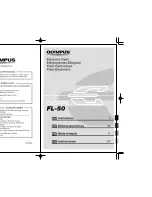
D I G I T A L T E C H N I C A L S U P P O R T
O L Y M P U S I M A G I N G A M E R I C A I N C .
( 8 8 8 ) 5 5 3 - 4 4 4 8
h t t p : / / s u p p o r t . o l y m p u s a m e r i c a . c o m
©2008 Olympus Imaging America Inc.
Page 5 of 26
Last updated on February 28, 2008
In the White Balance (WB) menu, what do all of those numbers
followed by a “K” mean?
The color balance of different light sources in the color spectrum is rated numerically by
color temperature in the standard Kelvin (K) temperature scale. A color temperature
value is expressed as a number followed by a “K,” for Kelvin.
The chart below shows approximate values of different light sources in the E-3 White
Balance menu:
•
5300K - For shooting outdoors on a clear day, or to capture the reds in a sunset
or the colors in a fireworks display.
•
7500K - For shooting outdoors in the shadows on a clear day. The light in
shadows areas is bluer, so this setting compensates for the color shift.
•
6000K - For shooting outdoors on a cloudy day. This setting makes the color
slightly warmer in tone.
•
3000K - For shooting under a tungsten light. This setting keeps the images from
coming out with a yellow color cast.
•
4000K - For shooting under white fluorescent lighting.
•
4500K - For shooting under a neutral white fluorescent lamp
•
6600K - For shooting under a daylight fluorescent lamp
•
5500K - For flash shooting
Color temperature settings can be applied in situations for which they are not intended
for creative effects. For example, a tungsten setting can be used on a cloudy day to
produce a surreal effect suggesting cold.
The Custom White Balance (CWB) settings in the White Balance menu allow photographers
to select more accurate color temperature settings. Many commercially available lamps
are labeled with color temperature ratings that fall between 3000K and 4000K, so a
photographer is able to set up the camera for more accurate color rendition.
With so many White Balance settings available, why and when
should I use One-Touch White Balance?
There are many light sources and situations that are not covered by Auto White Balance
or the other settings in the White Balance menu. There are many noncontinuous light
sources that do not have all of the colors of the spectrum, such as fluorescent, mercury
vapor, and sodium vapor lights. There are also situations in which many different types
of lights are used in one environment. These do not neatly fit into what the camera
firmware knows about white balance, so it is necessary to “educate” the camera about
the specific light balance by shooting a white reference subject such as a white card and
saving the data in the White Balance menu as a One-Touch White Balance.
In the PICTURE MODE > MONOTONE menu feature, what is the
purpose of the B&W Filter options?
In black-and-white film photography, different colored filters are placed in front of the lens
to modify the tones in the final image. These are called contrast filters. One popular
effect created with contrast filters results in a landscape photograph with majestic clouds
against an almost black sky. This effect is obtained by shooting through a deep red filter,
which makes the blue in the sky darker.
A general rule of thumb regarding the use of contrast filters is: The filter makes its own
color lighter in tone and its opposite color darker in tone.






































